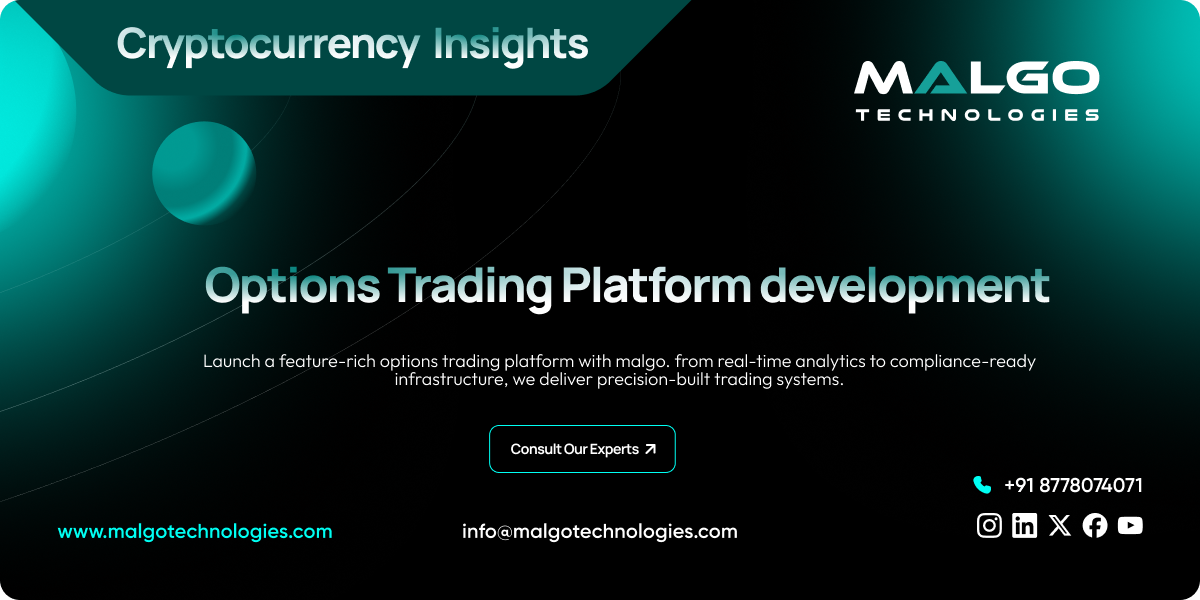Introduction
Digital finance continues to evolve, and options trading stands out as one of the fastest-growing segments in derivatives markets. With advanced tools, strategic flexibility, and increasing participation from both individuals and institutions, options trading platforms are becoming a key asset for fintech ventures.
Malgo builds advanced, regulation-aligned options trading platforms equipped with everything traders and operators expect—real-time data, strategic flexibility, and airtight security.
What is an Options Trading Platform?
An options trading platform is a digital system where users can buy and sell options contracts on assets like stocks, indexes, or cryptocurrencies. These platforms allow for speculation, hedging, and income generation by providing access to calls, puts, and complex strategies in a single interface.
Why Build a Custom Options Trading Platform in 2025?
With rising demand for transparency, data control, and strategic flexibility, off-the-shelf platforms often fall short. Custom-built platforms allow for integration with multiple markets, custom brokerage models, flexible fee structures, and advanced analytics—all of which are essential for standing out in a competitive trading environment.
Understanding Options Trading
Basics of Options: Calls vs. Puts
A call option gives the buyer the right to purchase an asset at a predetermined price. A put option gives the right to sell. Both are limited by expiration dates and priced based on volatility, underlying value, and time.
Key Market Participants
Retail Traders: Individuals leveraging mobile apps or web platforms to trade options.
Institutions: Hedge funds, banks, and trading firms using complex strategies.
Brokers: Intermediaries offering execution, margin accounts, and liquidity.
Why Options Trading is Gaining Popularity
Flexible strategies, lower capital requirements, and the ability to hedge or speculate in any market direction are driving adoption. Access has also improved thanks to modern platforms that offer intuitive interfaces and real-time data.
Core Features of an Options Trading Platform
Real-Time Market Data and Charting
Live pricing feeds and technical indicators are critical for decision-making. Malgo integrates high-performance data providers and custom charting libraries for a seamless experience.
Options Chain Visualization
An options chain allows users to see all available strike prices, expiration dates, and premium values in one view. This is a central interface for most traders.
Strategy Builder
Users can simulate and execute multi-leg strategies like spreads, straddles, strangles, iron condors, and more. Platforms support visual strategy construction with risk-reward previews.
Order Management System (OMS)
A modern OMS handles order routing, execution, position tracking, and historical trade logs with precision and speed.
Risk Management and Analytics Tools
Built-in tools assess real-time exposure, margin requirements, and Greeks (Delta, Gamma, Theta, Vega, Rho) to assist in strategic planning.
User Wallets and Fund Management
Secure wallet systems support fiat, crypto, or hybrid models. Transfers, withdrawals, and deposits must be handled with full audit trails and encryption.
KYC/AML and Compliance Modules
Integrated identity verification systems and transaction monitoring help the platform stay within global regulatory frameworks.
Admin Dashboard and Reporting Tools
Operators can view platform-wide performance metrics, user activity, compliance logs, liquidity sources, and revenue tracking.
Key Components in the Tech Stack
Front-End: React, Vue, or Angular for responsive, real-time user interfaces.
Back-End: Node.js, Django, or .NET to manage logic and high-volume transactions.
Real-Time Data: FIX and WebSocket for low-latency data and order execution.
Database & Caching: PostgreSQL or MongoDB for data storage; Redis for fast access.
Cloud & DevOps: AWS, Azure, or GCP with Kubernetes and Docker for scalable deployment.
Security: TLS/SSL encryption, MFA, and DDoS protection to ensure data safety.
Architecture of a Modern Options Trading Platform
Microservices vs Monolithic
A microservices architecture allows components like user management, order handling, and market data to scale independently, reducing downtime and risk of system-wide failures.
Event-Driven Systems
Event queues using Kafka or RabbitMQ manage thousands of simultaneous trades and user actions in real time.
Matching Engine Integration
In-house or third-party engines handle trade matching logic based on price, quantity, and time priority.
Scalability and High Availability
Auto-scaling, load balancing, and active monitoring systems prevent bottlenecks during high-volume events like earnings season or market-wide volatility.
Steps to Develop a Custom Options Trading Platform
Business Requirement Analysis
Work begins with detailed discovery of product goals, target audience, regulations, and expected transaction volume.
Platform Architecture Design
Engineers define data flows, user roles, API interactions, and integration points for third-party services.
UI/UX and Prototyping
Design teams develop wireframes and clickable prototypes to refine user flows before development begins.
Core Development and Integration
Front-end, back-end, matching engine, APIs, and admin systems are built and connected in modular stages.
Testing, QA, and Security Audits
Automated and manual testing is conducted, followed by code review and penetration testing to address any gaps.
Deployment and Maintenance
Once live, the platform is continuously monitored, updated, and supported through structured DevOps processes.
Challenges in Options Trading Platform Development
Handling Market Volatility and Traffic Spikes
Price swings often drive traffic surges. Platforms need resilient data handling and auto-scaling server clusters.
Ensuring 100% Uptime and Redundancy
Any downtime may lead to financial loss. Backup servers, data replication, and traffic rerouting are core strategies.
Preventing Front-Running and Manipulation
Rate-limiting, time stamping, and AI-based anomaly detection help mitigate manipulation risks.
Secure Authentication and User Data Protection
OAuth2, biometric login options, and end-to-end encryption protect access and sensitive user information.
Why Choose Malgo for Options Trading Platform Development?
Experience in Fintech and Trading Solutions
Malgo has built exchange-grade systems across spot, futures, and options markets, with proven reliability under stress.
Custom Development or White Label
Clients can launch fully custom trading solutions or select a pre-tested white-label foundation for faster go-to-market.
Security and Regulatory Expertise
Platforms are developed with international compliance in mind—supporting GDPR, MiFID II, SEC/FINRA, and KYC/AML best practices.
Ongoing Support and Scalability
Malgo provides performance monitoring, feature expansion, and multi-region scaling support for post-launch growth.
Final Thoughts
Options trading is no longer confined to a niche market. Whether you’re a brokerage, fintech startup, or established trading brand, building a platform that meets trader demands and regulatory expectations is a long-term investment in staying relevant. Malgo brings both the technical strength and market awareness to help make it happen.
Frequently Asked Questions
A digital system that enables users to trade options contracts, offering tools for market analysis, order execution, and risk management.
Custom platforms offer tailored features, branding, and scalability, providing a competitive edge over generic solutions.
Common technologies include React for front-end, Node.js for back-end, WebSocket for real-time data, and cloud platforms like AWS.
Malgo implements encryption, MFA, DDoS protection, and regular security audits to safeguard user data and transactions.
Platforms must adhere to KYC/AML, GDPR, and financial regulations like SEC or FINRA, depending on the market.


